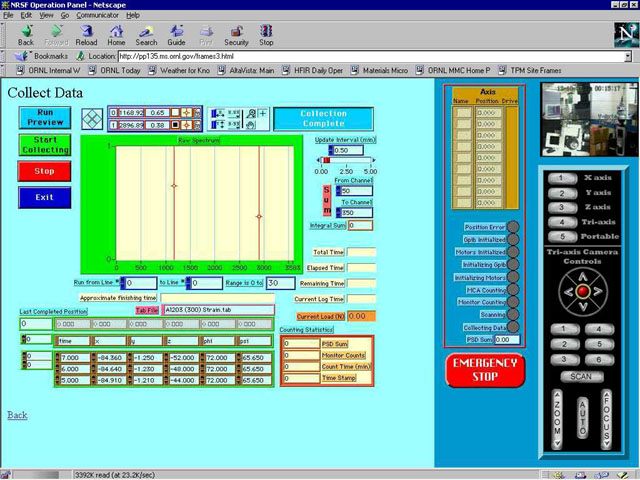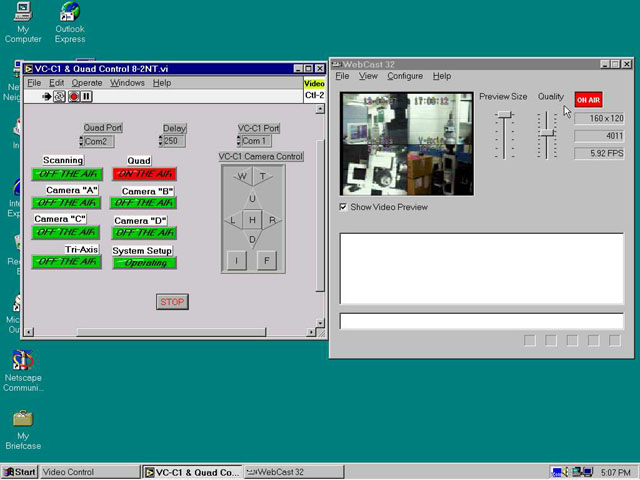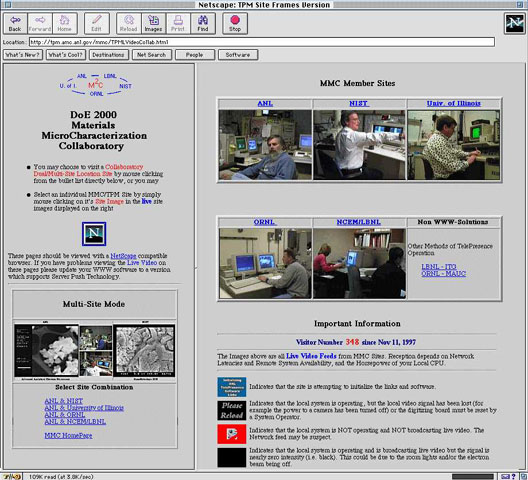The Materials Microcharacterization Collaboratory: Scientific Collaboration over the Internet
M.C. Wright and C.R. Hubbard
Oak Ridge National Laboratory
Introduction
The Materials Microcharacterization Collaboratory (MMC) was created last year as a pilot project within the US Department of Energy's DOE2000 program. DOE2000 is a new initiative to fundamentally change the way scientists work together. The DOE2000 program has three main goals: improved ability to solve DOE's complex scientific problems, increased R&D productivity and efficiency, and enhanced access to DOE resources by R&D partners. One of the strategies to meet these goals is the construction of national collaboratories. These provide the integration on the Internet of unique or expensive DOE research facilities and expertise for remote collaboration, experimentation, production, software development, modeling, or measurement. In addition, collaboratories will benefit researchers by providing tools for video conferencing, shared data-viewing, and collaborative analysis. Cooperative pilots projects, jointly funded by DOE2000 and a scientific program area, are expected to lead to clear success in the scientific environment: they are to provide new capabilities and to increase the efficiency of doing the work (e.g. reduce travel, increase communication, provide for sharing of data among formerly disparate environments).
While the MMC is centered around electron microscopy, beam line facilities also play an important role in the project. Included in this collaboratory are the Neutron Residual Stress Facility at ORNL's High Flux Isotope Reactor (HFIR), the X14A beamline at BNL’s National Synchrotron Light Source (NSLS) and potentially the UNICAT beamline at ANL’s Advanced Photon Source (APS). Microscopy is represented by the four DOE BES funded electron microscopy user centers located at ANL, LBNL, ORNL and the University of Illinois and by the DOE EE funded Materials Analysis User Center located at ORNL. Also included in the MMC project is the National Advanced Manufacturing Test Bed (NAMT) program of the National Institutes of Standards and Technology (NIST). Together, the participating Centers represent virtually every technique which employs electrons, ions, photons (including x-rays), and neutrons to elucidate the microstructure (internal or external) of inorganic materials. It is the intent of the MMC to join these centers of excellence into a single on-line interactive Materials Microcharacterization Collaboratory and thus increase the utilization of these capabilities while greatly decreasing the time constant associated with multidisciplinary materials research.
Prior Work in Remote Instrument Control
A significant amount of research into remote control of scientific instruments was being performed by several of the MMC partners before the formation of the Collaboratory. At ORNL the Remote Electron Microscopy project uses a commercial remote control program, Timbuktu, for network-based remote control of the Macintosh-based data acquisition system on a transmission electron microscope. Also at ORNL, the Harsh Environment Lab is remotely controlled using client/server software written in LabVIEW for Windows NT. At Lawrence Berkeley National Laboratory the Telepresence for In-Situ Microscopy uses a Unix-based client/server for control of a high voltage electron microscope. At Argonne National Laboratory's AAEM TelePresence Microscopy Site a variety of web-based tools have been developed for telepresence and instrument control.
MMC Overview
The goals of the MMC project are to
- Extend, improve and mold the electronic laboratory environments already in place at each of our Centers into a single cohesive virtual laboratory, accessible from anywhere on the Internet.
- Use the extended capabilities of the Collaboratory to address materials sciences research problems related to interfaces and surfaces in economically important materials of interest to DOE programs.
- Develop a functional, interactive electronic collaboratory having the necessary tools for operation by the microanalysis community; leading to a truly new paradigm in scientific research.
Our vision of the future is to place creative scientists having varying yet complementary expertise together in a new environment which allows convenient, rapid and dynamic interactions to flow unencumbered by the limits of time and distance. By doing so, we expect to not only foster, but enhance, the ability of these individuals to conceive and execute scientific research. It is not the instrumentation which produces the science but rather the individuals who formulate and execute experiments designed and carried out using the "tools" which they have at their disposal.
The Industrial Partners in the MMC are an important part of the collaboratory. Their cooperation, technical and financial assistance will greatly accelerate the objectives of this project. The current industrial partners are Gatan Inc., R. J. Lee Group., EMiSPEC Systems Inc., Philips Electronic Instruments, Hitachi Instruments, Inc., Japan Electron Optics Laboratories-USA, SUN MicroSystems, Graham Technology Solutions. More industrial partners are expected to join.
MMC Beamline Remote Control Activities
The requirements for remote operation of beamline facilities have many aspects in common with other types of facilities. We desire platform independent interfaces for axes & accessories, web or internet based control, collision protection and safeguards, video image feedback on system condition, and security for instruments and data. Likewise, the requirements for remote collaboration among experimenters at beamline facilities are common. We desire shared data processing and analysis, video conferencing, security for proprietary information and the ability to share use of licensed databases and software.
The Neutron Residual Stress Facility (NRSF) at HFIR is used for mapping of residual strain gradients within research and engineering size specimens (dimensions: mm to meter) due to joining, deformation processing, internal interfaces, etc. The facility currently shares time on a triple axis neutron spectrometer but a completely new goniometer system has been ordered. The current data acquisition software runs on LabVIEW on a PowerMac with motors controlled by several nuBus cards housed in an expansion chassis. Detector readout is through a GPIB interface. The motion control electronics for the new system will be interfaced through GPIB. Since versions of LabVIEW exist for Unix and Windows NT, we will be able to move the new system to either of those platforms should that prove to be desirable in the future. We have been remotely controlling the system using Timbuktu, which supports Macs and Windows (95 and NT) on either end of the connection. While very useful on our LAN, this approach has certain weaknesses as a general solution. Security is weak and the remote user has complete access to the local computer being controlled. Timbuktu traffic is not normally allowed through firewalls although this is not an issue at our site. Also, it is necessary to have a copy of Timbuktu on the remote computer.
An Internet Developers Kit is available for LabVIEW that allows the front panel of any open LabVIEW vi (subroutine) to be converted to a JPEG image that is visible through a web browser. The screen shot in Figure 1 shows an example of the remote status screen for NRSF now available through the web. The frame on the left is "Collect Data", one of eight vi's that the users frequently access. (There is no data visible since the system is currently offline for software development.) In the middle is the "Global Status" vi that shows current motor positions and system status. These images are automatically updated by the web server at a selectable interval, 10 seconds being appropriate for this instrument. These frames show the status of the data acquisition system but do not provide control. At present, we overlay the images with an image map that allows the user to "push" the buttons that call and exit the various vi's in the overall system. We also have a simple html form that allows the motors to be moved remotely. This approach is useful as a demo but a practical implementation will require the use of Java. We are just beginning the design of the Java-based control system and are also considering the use of CORBA in our design.

Figure 1. Screen shot of the web-based live status and video display for the NRSF at HFIR.
The frames on right show live video images of the instrument and a control panel to select the camera to use and to control the steerable camera. There are five cameras connected to an RS-232 controlled video switch box that can also combine four of the cameras into the quad image view shown in the figure. The steerable camera is also connected to the computer via RS-232. The control panel is currently an image map that executes Perl scripts but we plan to convert this control to Java in the near future. The steerable camera is important for the remote user to have a sense of "being there" by being able to choose where in the room to look. Three of the fixed camera are positioned on orthogonal axes pointing at the sample. They are equipped with electronically generated cross hairs to precisely indicate the location of the sampling region. The fifth camera is mounted on a flexible goose neck so that it can be easily repositioned to look at a region of interest for a particular experiment.
The live video is generated by a commercial product named WebCast. A Windows NT system with a video capture card and a copy of the WebCast client software sends compressed video over the network to another NT system running the WebCast server which can assimilate several video streams and broadcast them over the web. The video is broadcast as streaming JPEG's so no software other then the browser is required on the client end to view the video. Figure 2 shows a screen shot of the NT system running the WebCast client and the camera and video switcher control software. Our network is currently 10Mbps ethernet but we are installing ATM for higher performance and security.

Figure 2. Screen shot of the NRSF video server showing the LabVIEW control panel for the video switcher and steerable camera and the WebCast client software for transmitting live web-based video.
Beam line X14A, an ORNL-U of Illinois PRT, at BNL’s National Synchrotron Light Source (NSLS) is used for a wide range of x-ray diffraction studies, for example, growth stresses in protective oxide films grown in situ, HT phase transitions and solid state reactions, and defect characterization by diffuse scattering. The data acquisition system at X14A is being upgraded and the possibilities for web-based control are being evaluated. Meanwhile, we are in the process of installing a WebCast video system at X14A. We are also participants in the UNICAT beamline at APS but have not yet made specific plans for web-based control at that facility, but expect to do so in the future.
MMC Approach to Security
Security is vital on the web. We are putting valuable and complicated facilities online to the whole world. If security “gets in the way” it will not be used but if it is too weak, valuable assets will be at risk. A full discussion of our security plans is beyond the scope of this paper but further discussion can be found through our project web site. Briefly, we plan to use an X.509 certificate system to control access to our facilities and to encrypt the information traversing the network. Certificates are now supported by Netscape and Internet Explorer but are not yet widely used. However, the need for strong security for electronic commerce on the web is driving major developments in this field and we expect the certificates infrastructure and tools to be common place in the near future. We also plan to use authority certificates in addition to authentication certificates to provide more fine grained control over the functions that a remote user is allowed to perform on the instrument.
Summary of Other MMC Activities in Remote Collaboration
If scientists are to be able to work together they must be able to share access to the experimental logbooks. One of the DOE2000 technology R&D projects is centered around the development of an Electronic Notebook. The notebook is a collection of web pages that are created and viewed through a browser. Video conferencing is also important for collaboration. The mbone tools (vic & vat) work well on Unix, work marginally on Windows, and are essentially nonexistent on the Macintosh. CU-SeeMe works on Mac's and PC's but not on Unix and must use a reflector for multiway conferences. Other products are just coming on the market but typically only support Windows PC's. Surprisingly the video works much better than the audio since dropped frames on video are annoying but gaps in the audio stream are intolerable. In addition, network latencies frequently cause a few seconds delay in the audio making normal conversation impossible. For now, we are using conference calls on the telephone combined with video through CU-SeeMe for our weekly project meetings. Commercial market forces are causing frequent advances in this technology and we expect the situation to improve in the reasonably near future.
For one-to-many type transmissions, we have found that web-based streaming JPEG's work very well. Figure 3 shows a page with 5 live video feeds, one from each of the main MMC sites. These video streams perform very well and require no special software on the receiving end. The thumbnail in the lower left corner of the figure shows the multi site collaboration mode for use of this technique. The smaller images in the center show the operators of two different microscopes and the larger images show the live images coming from each microscope.

Figure 3. Screen shot showing five live video feeds on a single web page. No plug-in is required to view the video streams.
Summary
MMC is about remote scientific collaboration and not just remote instrument control. While the project is centered around electron microscopy, beamlines are an important part of the project. They are included to ensure that the tools and techniques we develop will not be useful only for microscopy. We are continuing to refine our independent approaches while migrating to a common web-based approach. We have made significant progress in web-based experiment monitoring and experimenter interaction and have begun to implement secure web-based experiment control.
Acknowledgements
The MMC project is a true collaboration of many people. The authors want to recognize the important contributions of the following individuals: Kathleen Alexander, Edgar Voelkl, Larry Allard, Jim Rome, Bryan Allen, David Schenk, and Gene Ice of Oak Ridge National Laboratory; Nestor Zaluzec and Rick Stevens of Argonne National Laboratory; Michael O'Keefe, Ulrich Dahmen, Bahram Parvin, and John Taylor of Lawrence Berkeley National Laboratory; Jim Mabon of the University of Illinois, Urbana-Champaign; and Clayton Teague, Dale Newbury, Eric Steel, and Michael Postek of the National Institutes of Standards and Technology.
Department of Energy funding for the MMC is provided by 1) Office of Energy Research, Office of Computational and Technology Research, Division of Mathematical Informational and Computational Sciences (DOE/OER/OCTR/MICS); 2) Office of Energy Research, Office of Basic Energy Science, Division of Materials Science (DOE/OER/BES/DMS); 3) Energy Efficiency and Renewable Energy, Office of Transportation Technology (DOE/EERE/OTT). Department of Commerce funding is provided by the National Institute of Standards and Technology's National Advanced Manufacturing TestBed Program (DOC/NIST/NAMT). Additional funding is provided by the industrial partners mentioned above. ORNL is managed by Lockheed Martin Energy Research under contract number DE-AC05-96OR22464.

